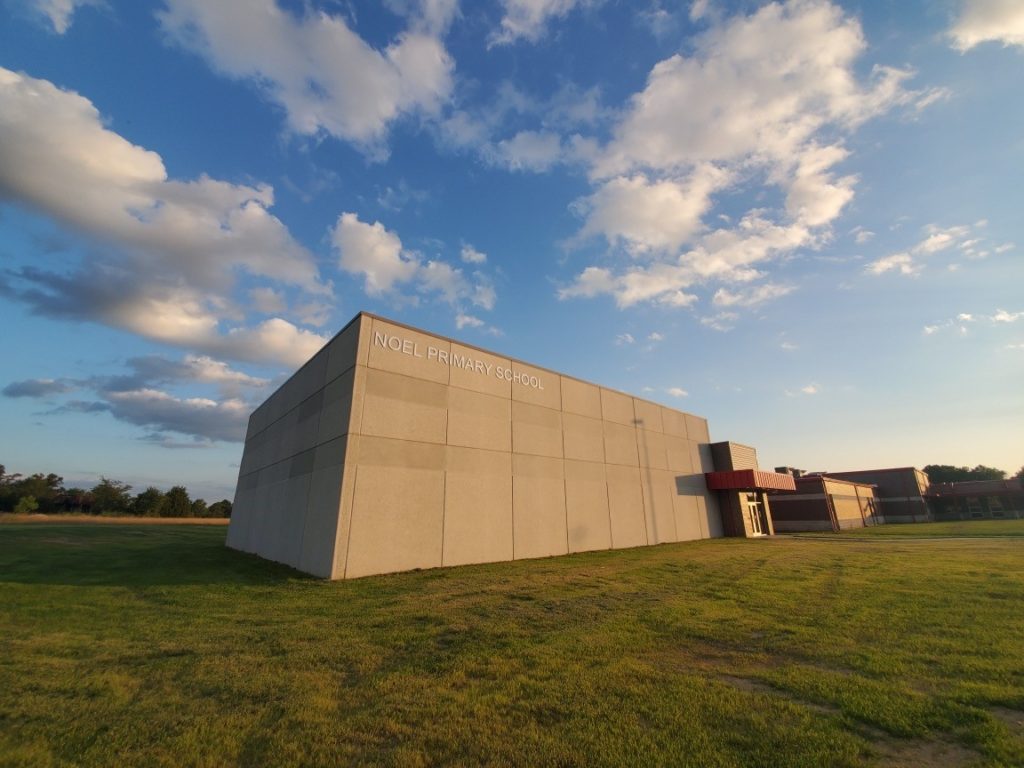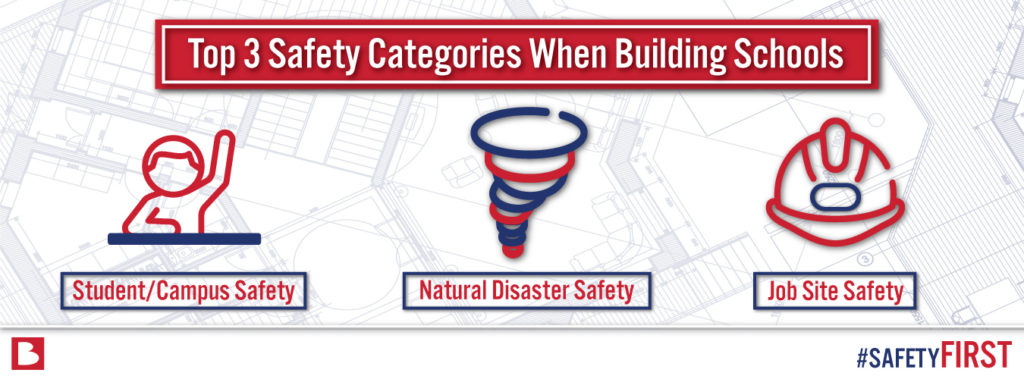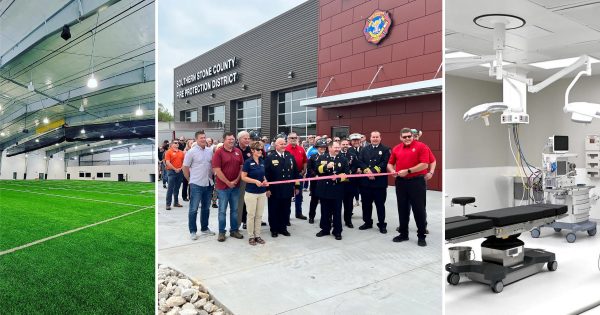No parent should fear sending their children to school due to risks surrounding natural disasters, school shootings, or any other unsafe conditions. Instead, school buildings should protect students and provide them with a safe haven from any of these potential dangers, giving parents peace of mind on the safety of their children. Teachers, staff, and students can focus on learning without distractions.
Construction firms should work to instill safe designs in new schools and to retrofit them in existing unsafe schools. Although there are no quick fix responses to the tragedies that have occurred in schools throughout the country, there are evidence-based designs for altering school environments to make students, teachers, and staff feel safer.
There are many different aspects of safe school building and steps school district leaders and builders can take towards improving the safety of their school. Safety should be an integral part of the design process in schools.
Brad Erwin from Paragon Architecture sees collaboration between the design team, general contractor, and owner as the overall key.
“I think what’s really nice is that we’re getting some great buy-in from community, administration, and boards of education to make sure those safety and security measures are thought of as part of an early part of the design process, so that it’s designed integrally into the facility,” Erwin said. “It’s not an add-on later or an after-the-fact after it’s constructed.”
This not only allows each aspect of the project to be discussed and also ensures that goals are clearly communicated and expectations are established in the pre-construction period.
Designing Schools to be Secure from Intruders and Attacks
In the aftermath of numerous school shootings over the past decades, school officials are searching for the best methods of improving the building design of schools for maximum security. These methods include:
- Making layers of zoning: Schools should be designed with one main point of entry that can be monitored by faculty. If other exits are required due to fire safety regulations, they should only be able to open from the inside.
- Constructing fences and walls: From a safety perspective this is the most effective method and can be aesthetically designed to fit the school’s needs. If fencing is not an option, it is also possible to create a secure perimeter by building the exterior walls out to meet the sidewalk.
- Adding foolproof alarm systems and bulletproof glass: These can help eliminate any other vulnerabilities that may occur in an active shooter situation.
- Window tactics: While bulletproof glass is a full-proof solution, it is also more expensive than many schools can afford. As an alternative, schools are designing windows to be located out of the line of sight of the students inside.
- Safe zones: Having architects implement safe zones that are out of sight from windows or behind a wall and marking it with different colored or patterned flooring can help students utilize these areas to deter potential intruders.
- Surveillance methods: Many public schools are installing surveillance cameras as a solution to preventing any suspicious behavior by allowing security officers to observe campus activity.
Protecting Schools from Natural Disasters
Another potential threat to occupants of school buildings is from natural disasters. These can vary greatly depending on the school’s geographical location, but many schools are faced with developing design plans that mitigate the effects of tornadoes, hurricanes, earthquakes, and floods.
With the rise of natural disasters, architects and builders are also utilizing new technology and materials that can stand in the wake of extreme storms and weather. Using these materials allows schools to recover quickly afterward and spend less money doing so.
One of these new methods is creating load path continuity to connect all the materials from the roof, to the wall, to the foundation in order to prevent the roof or any other integral pieces from detaching.
Construction firms are also striving to use materials that can withstand high winds and flying debris like laminated windows and metal bracing. Steel building frames are particularly helpful in order to create ductile structures that can withstand significant damage and not lose their strength.
New technology and materials are constantly evolving to meet the needs of builders tasked with constructing schools that are able to endure the forces of mother nature.
School Safe Room Building & Design

One of the biggest approaches to refining school safety is building a safe room. A safe room is a hardened structure designed for protection from extreme weather events that can provide near-absolute protection to its occupants. This prevents the risk for loss of property, injury, or death.
These safe rooms are often used as dual spaces. Meaning, not only are they used to provide protection from a wide variety of natural disasters, they are also used for schools to provide extra space and storage. Many new schools are incorporating safe rooms into their blueprints and many older buildings are adding them to their renovation or addition projects due to the convenience and comfort they provide.
Many schools build safe rooms as Federal Emergency Management Agency (FEMA) Shelters for the entire community. This is a great solution for schools due the Hazard Mitigation and Pre-Disaster Mitigation Grant Program that pays for 75% of safe room costs.
In order for schools to receive this funding they must apply through the State Hazard Mitigation Office and build their safe room according to precise specifications according to the most recent FEMA publications and all Federal, State, and local codes.
These guidelines are vital to the safe rooms ability to effectively provide near-absolute protection in the event of extreme weather. Because of this, it is imperative that schools have workers with extensive experience and knowledge of the critical components of a safe room to ensure it is designed and constructed to meet proper standards and specifications.
The level of protection a safe room provides is determined by its designed ability to hold up against high wind speeds, pressure, and debris. FEMA safe rooms must be designed and constructed according to the most recent edition of FEMA publications on Taking Shelter from the Storm: Building a Safe Room for Your Home or Small Business (FEMA P-320) and Safe Rooms for Tornadoes and Hurricanes: Guidance for Community and Residential Safe Rooms (FEMA P-361). If your school can’t receive FEMA funding, the same requirements will be required according to ICC 500 Building Code.
Your contractor needs to know how to build how to build you safe room and dual space according to these specifications, as well as how to properly sequence the construction events, identify long lead items, and assist with material selection.
For example, Branco was selected to help build three safe rooms as storm shelters for elementary schools in the Carthage School district. For this project Branco utilized pre-cast walls, poured all the concrete, and constructed all the foundation work and footings. Each of these stages, from concept to completion, must be done according to FEMA specifications to receive proper funding.
Occupied Campus Construction Site Safety
Without a safe construction building zone, the purpose of creating a safer environment for students is counter-intuitive. This is why you should strive to find a construction firm that makes it their top priority to ensure the safety of the building’s occupants and to allow normal activity to continue.
It is vital that your construction firm has vast experience in school renovations to alleviate any potential challenges during construction that may occur due to the school still being occupied. As a visitor on your campus, they should respect the needs of your faculty, staff, and students and coordinate construction activities around the ongoing activities at your school and minimize any noise, dust, deliveries, and site traffic.
To further ensure the safety of your faculty and students, the construction site should be treated with proper security. This means controlling all access to the job site and regulating the actions of all members of the project team. Every worker should be required to have background checks done and to wear hard hats with stickers to identify themselves.
The construction company should conduct periodic safety inspections, record all working conditions, and properly train their employees on preventing any unsafe working conditions that could potentially endanger your personnel or visitors. Children and teachers should feel secure and protected within the walls of the school, and your construction firm should do whatever they can to help achieve that level of security.
Collaborating with Community Leaders on Safety in School Construction
No one knows a school better than its faculty and administrators. Collaborating throughout the entire process allows discussion of any concerns regarding maintenance, operations, or safety.
It is vital to take any concerns from parents, students, and teachers into consideration in order to address any other potential safety issues. From the very beginning stages of the project, working with community leaders in the school and emergency response teams such as local police and fire departments for their input on the best regulations and building designs to promote safety helps improve the effectiveness of your project.
Involving the community and maintaining clear communication with the team at the school allows for clear expectations in regard to the steps and building process. Overall, all community members have the same priority of creating safety in school buildings and striving to amend any concerns. Branco is an experienced school builder with a passion for safety that operates in the Missouri, Kansas, Oklahoma, and Arkansas areas. If you are considering a retrofit or new build, please contact us today for input on how you can improve the safety of your campus.


